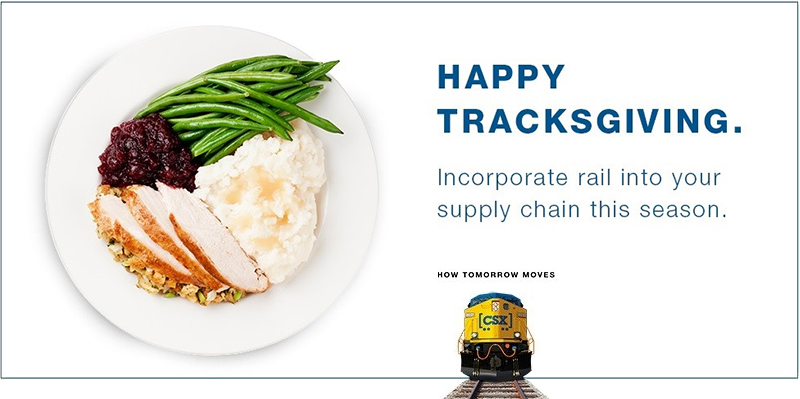It’s All About Options!

With a range of choices on the table, why rely on just one mode of transportation?
Diversify your supply chain plate this holiday season
From sweet potatoes to mashed potatoes, from green bean casserole to cranberry sauce, cooks around the country are getting ready to prepare a diverse array of dishes to complement the turkey this Thanksgiving.
This variety satisfies every taste and tradition and contributes to the memorable Thanksgiving Day experience.
And just as a Thanksgiving host wouldn’t risk serving a single dish, supply chain managers should not risk disrupting their companies’ freight flows by relying on a single mode of transportation.
Leveraging the strengths of various transportation modes creates a complementary mix of options leading to a well-balanced and diversified transportation network.
This is something shippers will be thankful for when today’s readily available capacity tightens in the coming months and years due to increasing over-the-road regulations combined with the growing driver shortage.
Avoid risk through proper planning
Strategic planning and preparation are key not only to a Thanksgiving meal’s success but to a supply chain manger’s success.
Prioritizing the wrong dishes during Thanksgiving can result in not enough time to finish the turkey and over-cooked sides. In logistics, moving freight with an intermodal alternative by truck can result in increased transportation costs and a wasted opportunity to use driver power on freight that is truly better suited for over-the-road shipping.
As shippers set out to build a balanced supply chain, they should examine their freight networks for sub-optimized freight. Sub-optimized freight is freight that is moving over-the-road when it is better suited to move via intermodal rail.
The general rule is that shippers should rely on over-the-road trucking for shorter lengths of haul, for just-in-time freight moves or for shipments direct to retail storefronts.
Shippers should turn to intermodal rail for inbound freight moves over 500 miles with lead time. Shipments between distribution centers and manufacturing sites are ideal for intermodal rail.
Prepare for tomorrow, today
As stewards of their organizations’ resources, supply chain leaders must not only plan and prepare for the issues of today, but for the unforeseen challenges of tomorrow. Proper planning and contingency plans are crucial to the success and health of a supply chain.
Matching freight with its most optimal transportation mode insulates the transportation network from the disruptions of tomorrow. A well-balanced modal portfolio is protected against single points of failure, allowing shippers to efficiently and reliably deliver their products despite fluctuating capacity and regulations within the marketplace.
Diversifying modal options today provides the necessary time to incorporate intermodal rail into an organization’s supply chain.
The recipe for a diverse supply chain
Since Thanksgiving is a time for beginning cooks and experts chefs alike to share best practices and swap recipes in the kitchen, CSXT Intermodal is sharing the key ingredients that new and seasoned supply chain leaders should look for when identifying freight that is fit for intermodal conversion.
Length of haul
Length of haul is an important consideration when evaluating freight for intermodal conversion. Intermodal rail is not only reserved for transcontinental and long-haul freight moves.
Many shippers are realizing cost-saving benefits of integrating intermodal rail for moves with lengths of haul as little as 500 miles.
In addition to length of haul, proximity to an intermodal terminal also determines whether the mode would provide benefits.
With a network that reaches 90% of the East Coast’s consumer population, CSXT is able to help shippers realize the benefits of intermodal for freight moves with both short and long lengths of haul.
Freight move type
Full truckload freight moves with lead time are best for intermodal conversion. Domestic intermodal rail moves freight in 53’ containers that can be double-stacked on trains for increased efficiency. Due to the efficiency of double-stacking containers, one intermodal train can move the equivalent of 280 trucks. The intermodal experts at CSXT can help evaluate your truckload conversion opportunities.
Commodity characteristics
Intermodal rail is versatile and carries many of the items you use on a daily basis, including food products, consumer goods, electronics, clothing and more. It’s not just finished goods that can benefit from intermodal rail. Inputs like plastics and paper as well as auto parts can also benefit from multimodal transportation. Generally, containerized, non-perishable, palletized goods tend to be the best fits for intermodal.
Stage of supply chain
Inbound freight moves are ideal for intermodal rail. Intermodal rail is optimal for shipping freight between manufacturing sites, distribution centers and warehouses. In some cases, less time-sensitive products moving to retail locations are also a fit for intermodal. Because Intermodal requires slightly longer lead time, the stage of the supply chain, along with proper demand planning, is critical.
Modal diversity reduces risk and promotes a healthy, balanced supply chain
The key to a balanced supply chain plate is not relying on a single mode of transportation, but on building a diverse portfolio of different modes, ensuring each specific freight move is moving on the most efficient, sustainable and cost effective mode possible.
As Thanksgiving plates around the country are filled with a variety of different dishes, supply chain managers should explore their networks for modal diversification opportunities.
Jumpstart your organization’s modal diversification today by requesting your complimentary supply chain analysis to identify freight in your network that is best fit for intermodal conversion.
Give thanks for choices. CLAIM YOUR ANALYSIS NOW.
Intermodal Rail White Papers & Guides
The X’s and O’s of Intermodal Rail in Supply Chain Management
As the coach of your supply chain, you have the opportunity to turn to your playbook and choose from multiple transportation modes to maximize the efficiency of your freight network. Download Now!
The Intermodal Rail Bracketology Guide
Learn how to identify sub-optimal full-truckload freight that is vulnerable to capacity constraints if and when a supply chain disruption occurs. Download Now!
Practical Steps for Highway to Intermodal Rail
Learn how to increase access to capacity, reduce transportation costs and mitigate exposure to future trucking regulations. Download Now!
Transportation Management Systems & Intermodal Rail
An interactive, personalized guide to learn more about the combined benefits of a TMS and intermodal rail. Download Now!
Highway to Intermodal Rail (H2R) Conversions Deliver Bottom Line Results
CSX Transportation has found that 96% of shippers have sub-optimized freight in their network. Does your organization? Find out and learn how to address sub-optimized freight in your supply chain. Download Now!
Article Topics
CSX News & Resources
Signs of progress are being made towards moving cargo in and out of Baltimore Top CSX executive places a sharp emphasis on railroading as a career path and service at NEARS Intermodal innovation? Crisis averted on U.S. railroads, with carriers and unions reaching tentative agreements CSX’s acquisition of Pan Am Railways is a done deal Baltimore breaks ground for double-stacking 126-year-old tunnel in ‘absolute game-changer’ CSX executive discusses railroad trends and themes at NEARS conference More CSXLatest in Transportation
Baltimore Bridge Collapse: Impact on Freight Navigating Amazon Logistics’ Growth Shakes Up Shipping Industry in 2023 Nissan Channels Tesla With Its Latest Manufacturing Process Why are Diesel Prices Climbing Back Over $4 a Gallon? Luxury Car Brands in Limbo After Chinese Company Violates Labor Laws The Three Biggest Challenges Facing Shippers and Carriers in 2024 Supply Chain Stability Index: “Tremendous Improvement” in 2023 More Transportation





















